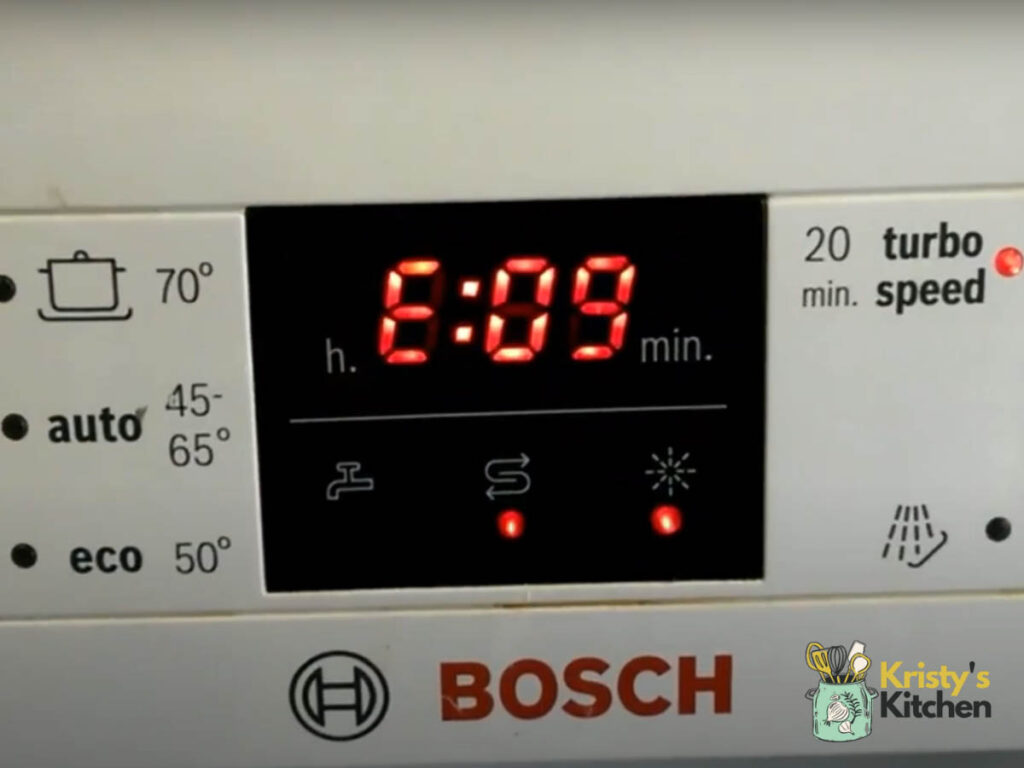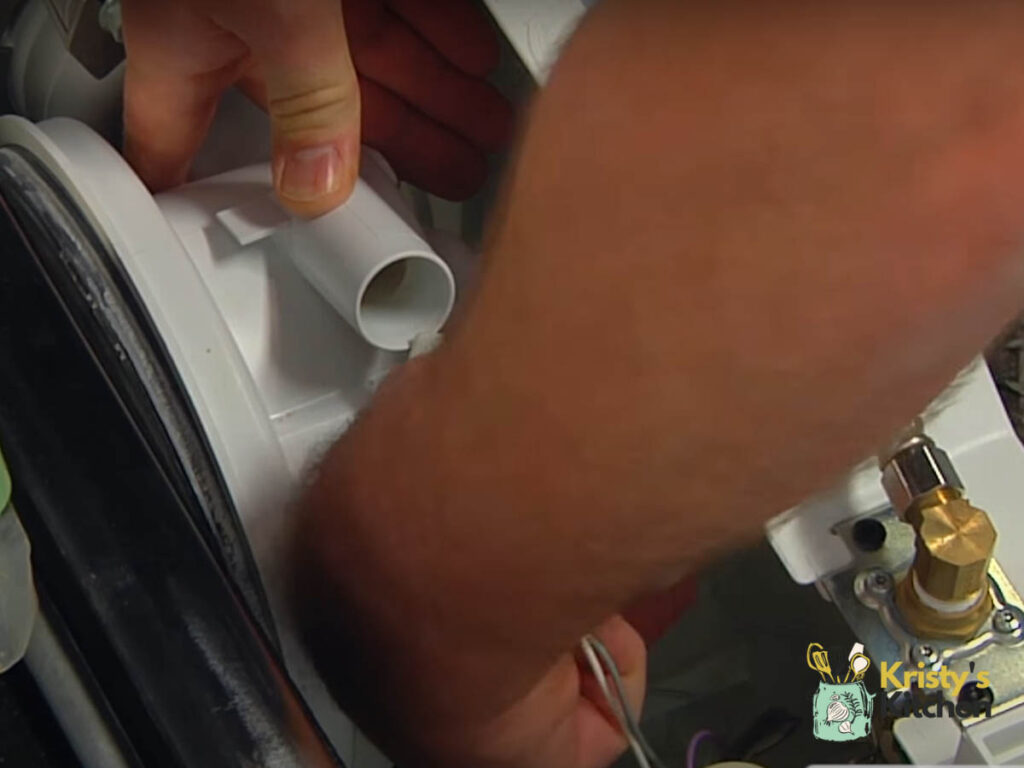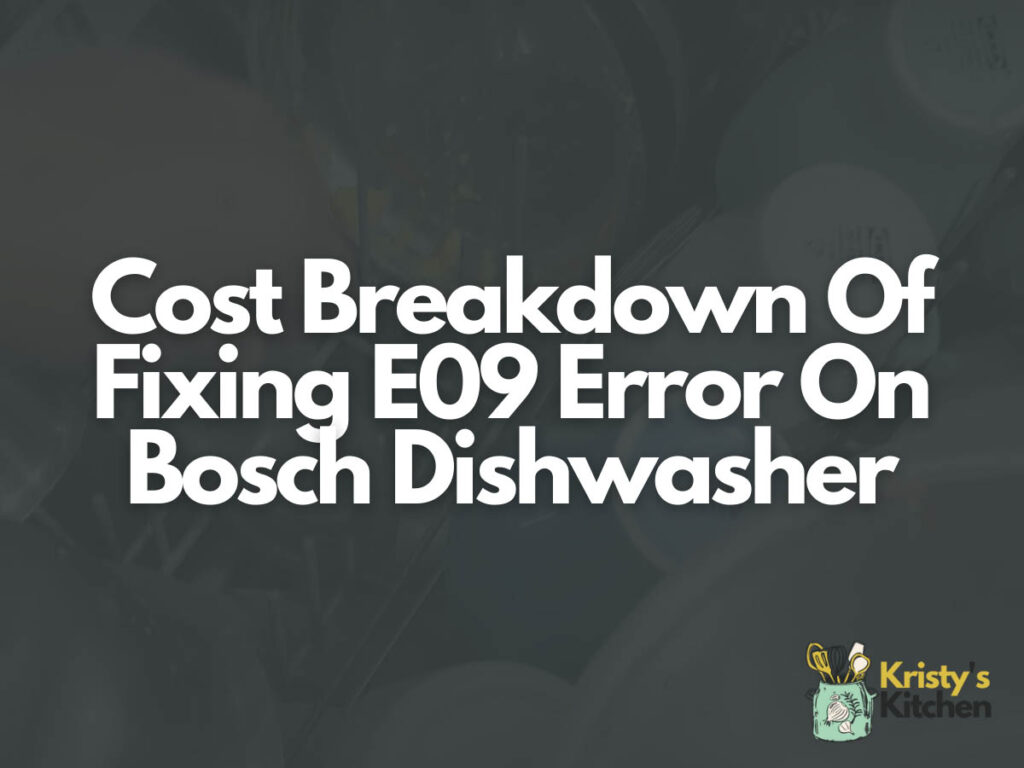Bosch Dishwasher E09: Getting Cold Washes?
If you find yourself puzzled by the sudden lack of warmth in your once hot and steamy dishwasher cycles and the E09 code on the control panel, it’s time to pay attention.
The last thing you want is to unknowingly serve your family germ-ridden dishes.
So, what does E09 mean on a Bosch dishwasher?
Bosch Dishwasher E09 error indicates a dirty salt sensor or issues with the heating element or relay. The fix is as simple as cleaning the sensor or, in worst cases, replacing the heating components.
I’ll walk you through the testing, fixing as well as the entire replacement process for all the needed parts.
Let’s get your dishwasher up and running again, shall we?
What Causes Bosch Dishwasher E09 Error

The infamous Bosch dishwasher 09 error can be quite a headache but fear not, let’s start with breaking down the possible culprits:
Problems with the Heating Element
The heating element in your Bosch dishwasher is like a little heater that warms up the water for effective cleaning.
If there’s something wrong with the heating element, it can trigger the E09 error.
Why The Heating Element Fails
Here are some reasons why the heating element might fail:
- Burnt Out: Over time, the heating element can burn out, leading to a loss of its heating capacity. This can happen due to regular wear and tear or power surges.
- Water Inside: Sometimes, water can seep into the heating element, causing a short circuit or malfunction. This often occurs if the dishwasher has a leak or if the heating element is not properly sealed.
- Clogged Drainage Filter: A clogged filter can obstruct the water flow to the heating element, affecting its performance.
- Hard Water and Scaling: Mineral deposits from hard water can accumulate on the heating element, reducing its efficiency. This is common in areas with hard water, and regular descaling is necessary to maintain the heating element’s effectiveness.
- Developed Holes: In some cases, the heating element may develop holes, allowing water to penetrate, resulting in failure. This can happen due to corrosion or physical damage to the element.
- Slow Water Circulation: Insufficient water circulation inside the dishwasher can lead to overheating of the heating element. This can occur if there’s a problem with the water pump or if the water jets are blocked.
Something Up With the Control Board Heater Relay
The control board heater relay is responsible for sending signals to the heating element, instructing it when to turn on and off.
Why The Control Board Heater Relay Fails
The control board heater relay can fail due to various reasons, including:
- Electrical Issues: Electrical surges, faulty wiring, or damaged components can cause the control board relay to malfunction.
- Component Wear: Over time, the control board relay’s components may wear out, affecting its ability to send signals accurately.
- Manufacturing Defects: In some cases, the control board relay may have manufacturing defects that lead to premature failure.
Something Up With the Salt Sensor
The salt sensor in a Bosch dishwasher monitors the salt levels in the water softener, ensuring proper water softening for effective cleaning.
If something’s up with it, it might cause the E09 error to pop up as a side effect. You’ll also notice the Salt LED light up.
Why The Salt Sensor Fails
The salt sensor may have issues due to these factors:
- Accumulation of Residue: Over time, the sensor can get covered with mineral deposits or other gunk from the water softener, making it less effective.
- Sensor Damage or Corrosion: Physical damage or exposure to salty or harsh chemicals can harm the sensor, causing it to stop working correctly.
- Electrical Faults: If there are problems with the electrical connections, the sensor might not send the right signals to the dishwasher’s control board.
- Clogging or Blockage: Debris or objects can sometimes block the sensor’s detecting area, preventing it from reading salt levels accurately.
- Age and Wear: Just like how things can get old and worn out, the sensor can degrade with time and prolonged use.
- Manufacturing Defects: In rare cases, there could be a flaw in the sensor from when it was made, which could lead to early failures.
How to Solve Bosch Dishwasher 09 Fault

If your Bosch dishwasher displays the E09 error, follow these step-by-step solutions to resolve the issue.
How Do I Test A Bosch Dishwasher Heating Element?
Follow these steps carefully while testing the heating element:
- Locate the dishwasher’s power cord or turn off the circuit breaker that supplies power to the dishwasher.
- The heating element is typically located at the bottom of the dishwasher’s tub.
- Open the dishwasher door and remove the lower rack to access the heating element.
- Set your multimeter to the resistance mode (ohms) and test the heating element’s terminals.
- Remove the wires connected to the heating element and place the multimeter probes on the element’s terminals.
- If the reading shows infinite resistance (OL), the heating element is faulty and needs replacement.
How Do I Clean The Heating Element In My Bosch Dishwasher?
Here are thorough steps for cleaning the element:
- Disconnect the dishwasher from power by turning off the circuit breaker or unplugging it.
- Open the dishwasher door, pull out the lower rack, and find the heating element at the bottom.
- Check the heating element for any visible debris or food particles.
- Gently remove any loose debris by hand or use a soft brush to clean the surface.
- Create a cleaning solution by mixing warm water with a mild dishwasher-safe detergent or dishwasher cleaning agent.
- Avoid using harsh chemicals or abrasive cleaners that could damage the heating element.
- Dip a soft cloth or sponge into the cleaning solution and gently scrub the heating element’s surface.
- Pay particular attention to any areas with mineral deposits or stubborn stains.
- After cleaning, rinse the heating element with clean water to remove any detergent residue.
- While cleaning, inspect the heating element for any signs of damage, such as cracks or holes.
- Before reinstalling the lower rack or using the dishwasher, allow the heating element to air dry completely.
- Once the heating element is dry, carefully slide the lower rack back into the dishwasher’s tub.
How Do I Replace The Heating Element In My Bosch Dishwasher?

If you notice any damage, consider replacing the heating element to avoid potential issues:
- Disconnect the dishwasher from the power and water supply.
- access the heating element by opening the dishwasher door and removing the lower rack. You may need to remove the lower spray arm and other components to access the heating element.
- Carefully detach the wires connected to the heating element.
- Take a picture or label the wires to remember their proper positions during reinstallation.
- Unscrew or unclip the heating element from its position. The method of removal may vary based on the model. Some heating elements are held in place with screws, while others may have clips or brackets.
- Place the new heating element and secure it in place following the reverse of the removal procedure.
- Attach the wires to the new heating element securely. Double-check the connections to ensure they are correct and tight.
- Before fully reassembling the dishwasher, reconnect the power and water supply.
- Run a test cycle to ensure the error is resolved and the new heating element functions properly.
How Do I Test A Bosch Dishwasher Control Board Heater Relay?
Now, let’s go through what you can do about your Control Board:
- Make sure the dishwasher is completely powered off to avoid electrical accidents.
- The control board is usually found behind the dishwasher’s control panel.
- Depending on the model, you may need to remove the front panel to access the control board.
- Set the multimeter to the appropriate setting and test the continuity of the heater relay. Touch the multimeter probes to the relay’s terminals while activating the relay (turning on the dishwasher).
- If there is no continuity when activated, the relay is faulty and needs replacement.
How Do I Replace The Control Board In My Bosch Dishwasher?
If you think yours needs replacing, let me walk you through the process:
- Ensure the dishwasher is not connected to any power source.
- To replace the control board, you’ll need to access it.
- Remove the dishwasher’s front panel following the user manual’s instructions.
- Carefully disconnect all wires connected to the control board.
- Take a picture or label the wires to remember their proper positions during reinstallation.
- Unscrew or unclip the control board from its position.
- Place the new control board and secure it properly using screws or clips.
- Attach all wires to the corresponding ports on the new control board.
- Ensure the connections are secure and accurate.
- Before fully reassembling the dishwasher, reconnect the power supply.
- Turn on the dishwasher and run a test cycle to ensure the error is resolved and the new control board functions correctly.
You should be free of the error afterward.
Bosch Dishwasher Salt Sensor Location
The salt sensor is usually located near the bottom of the dishwasher’s interior, close to the water softener compartment.
Refer to the user manual for specific details on the sensor’s location in your dishwasher model.
Bosch Dishwasher Salt Sensor Cleaning
Cleaning the salt sensor is a lot safer and easier than doing so with the heating element, here’s what you can do:
- Disconnect the power supply to the dishwasher to avoid any electrical hazards.
- Open the dishwasher door and locate the salt sensor. Depending on the model, it may be visible on the bottom of the dishwasher or hidden behind a cover.
- Gently clean the salt sensor using a soft cloth or sponge to remove any dirt or debris that might be affecting its performance.
- Take care not to apply excessive force, as the sensor is pretty sensitive.
Bosch Dishwasher E09 Reset
To reset and clear this Bosch dishwasher error code, follow these steps for a basic reset:
- Press and hold the “Start” button for about 3 to 5 seconds.
- Allow the dishwasher to reset and restart.
- After the reset, check if the E09 error code is cleared.
Cost Breakdown Of Fixing E09 Error On Bosch Dishwasher

The good news about fixing this particular error is that common repairs won’t break the bank. Let’s see what you might expect:
How Much Does It Cost To Replace A Heating Element In A Dishwasher?
Alright, so your dishwasher’s heating element needs to be swapped? No biggie! On average, you’re looking at around $50 to $150 for the replacement part, plus a bit more if you bring in a friendly neighborhood technician to help you out.
How Much Does It Cost To Replace A Control Board?
Uh-oh, if it’s the control board that’s causing trouble, things might get a tad pricier. But hey, chin up! A new control board for your Bosch dishwasher usually falls in the range of $100 to $300, and yes, you might need to shell out some extra cash for the technician to handle the installation.
| Just a quick heads-up: these costs are ballpark figures, and they might vary depending on where you live and which dishwasher model you’ve got. To get the exact scoop on what you’ll be spending, it’s always a good idea to reach out to some trustworthy repair services. |
How to Avoid Bosch Dishwasher E09 Error in the Future

To avoid that annoying E09 error in your Bosch dishwasher you’ll need to keep the heating element, control board heater relay, and salt sensor in good shape.
Here are some easy-to-follow tips:
- Keep Filters Clean: Remember to clean the filters regularly – the drainage and water softener ones. This helps prevent clogs that can mess up the heating element and salt sensor.
- Check Heating Element: Take a quick look at the heating element now and then. If you spot any discoloration or holes, it might need attention. You can test it with a multimeter.
- Remove Hard Water Buildup: For hard water areas, use a special cleaner to remove mineral buildup on the heating element. It’ll work better and keep the salt sensor happy.
- Monitor Salt Levels: Check and fill up the salt compartment regularly. This helps the dishwasher do its thing and keeps the salt sensor happy.
- Avoid Overloading: Don’t overload the dishwasher – it needs some breathing space! Overloading can stress out the heating element.
- Fix Leaks Quickly: If you spot water leaking, fix it right away. Water getting into the heating element or control board is bad news.
- Use Good Detergent: Get a good dishwasher detergent that’s made for your machine. It keeps things clean and prevents residue issues.
- Avoid Using Broken Parts: If anything seems broken, like the heating element or control board heater relay, hold off on using the dishwasher. Call a pro to fix it.
FAQs
Will Bosch dishwasher work if hot water heater is broken?
Sure! The dishwasher will work, but it might not be as effective. It’ll use cold water, which means longer wash times and not-so-great cleaning results. Better to fix that hot water heater for a top-notch performance.
What builds up on heating element in dishwasher?
Mineral deposits from hard water can build up on the heating element. That stuff is mainly calcium and magnesium.
Is the E09 error covered under Bosch dishwasher warranty?
It depends on the warranty terms. If it’s a manufacturing issue or a faulty part, it might be covered. But if it’s because of misuse or lack of maintenance, it might not be. Check the warranty details or talk to Bosch customer support to be sure.
Final Thoughts
You’ve got this! By following these simple tips and taking good care of your Bosch dishwasher, you’ll keep that E09 error at bay.
Your dishwasher’s heating element, control board heater relay, and salt sensor will thank you for it!
And if anything breaks, don’t worry, since you know the fix to every possible way to get rid of this error now.
Happy dishwashing!
